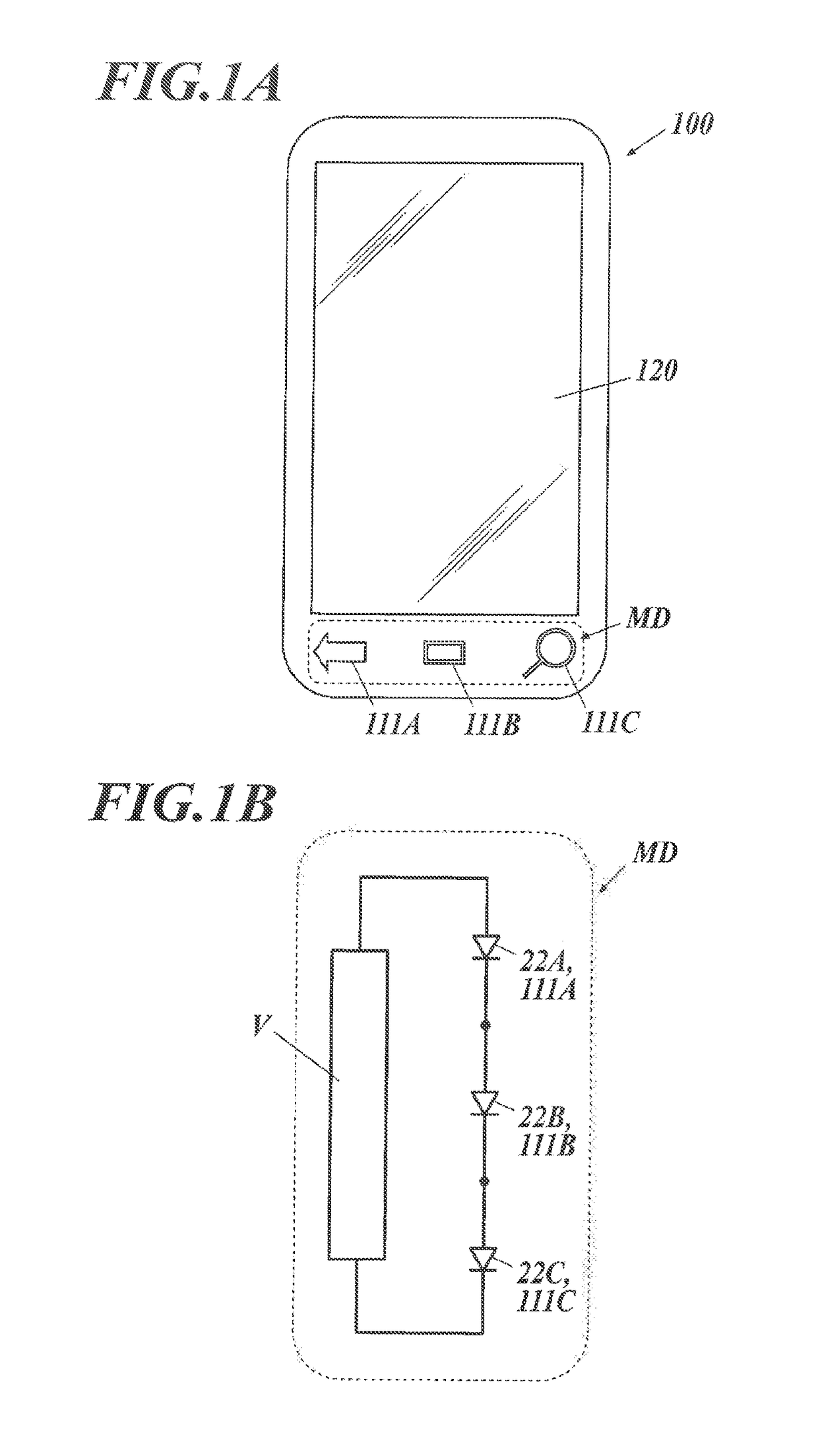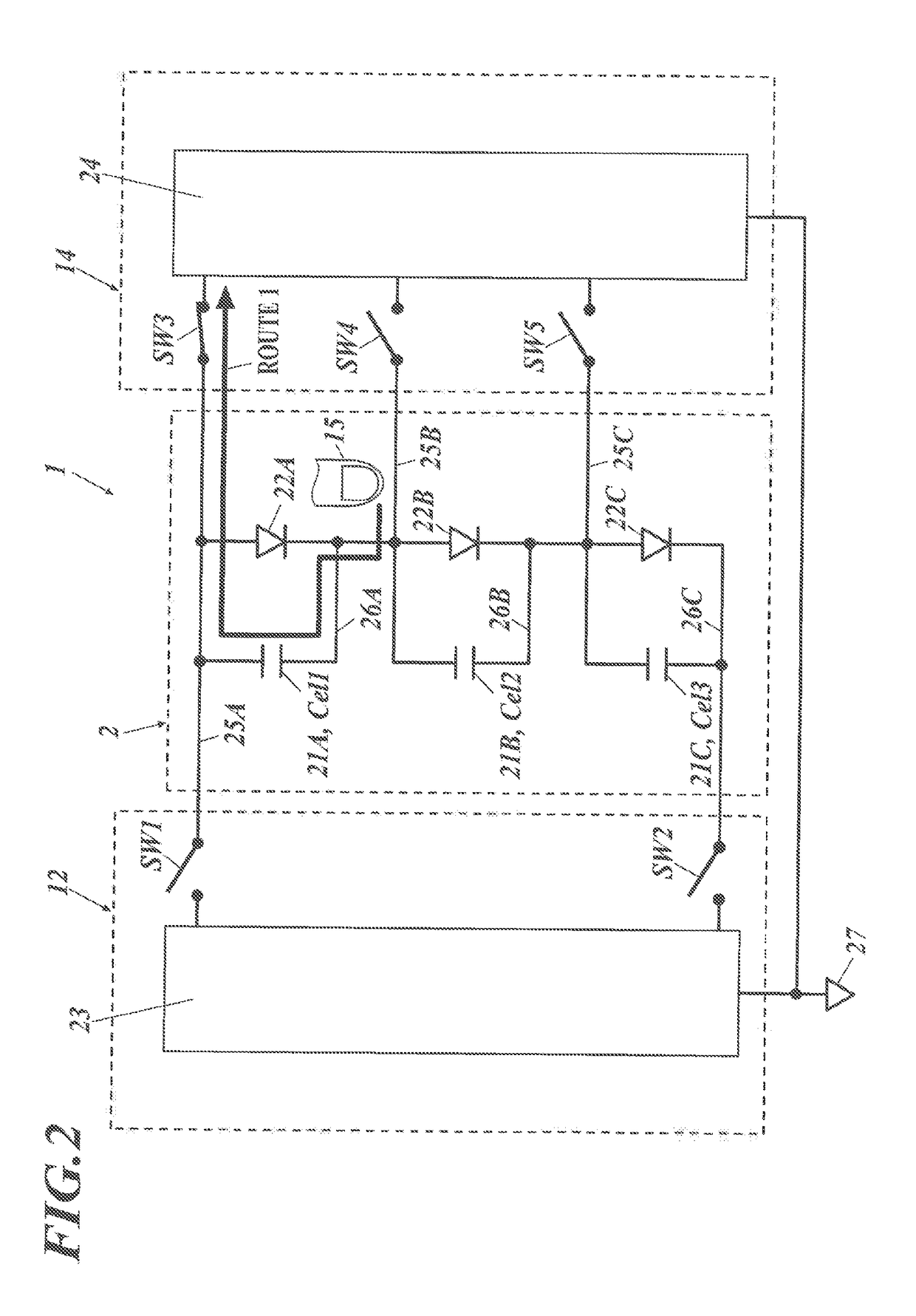Organic electroluminescent module, smart device, and illumination apparatus
a technology of electroluminescent modules and smart devices, applied in the direction of instruments, computing, electric digital data processing, etc., can solve the problems of affecting the detection of the variation of capacitance in the surface capacitive scheme, increasing the thickness of the device, increasing the production steps, etc., to prevent the error of touch sensing in the touch function, small thickness, and small format
- Summary
- Abstract
- Description
- Claims
- Application Information
AI Technical Summary
Benefits of technology
Problems solved by technology
Method used
Image
Examples
embodiment 1
[0114]FIG. 4 illustrates an example of a driving circuit in the configuration (Embodiment 1) having switches between three organic El elements in an organic EL module of the present invention.
[0115]In FIG. 4 illustrating a circuit diagram for driving the organic EL module (1), in the same manner as in FIG. 2, the organic EL panel (2), which is illustrated on the middle of the drawing, includes an anode lead (25A to 25C) and a cathode lead (26A to 26C). Three organic EL elements (22A to 22C) (being a diode) and a parasitic capacitance (21A (Cel 1) to 21C (Cel 3)) of the organic EL elements are connected to the both leads.
[0116]In the light-emitting device driving circuit unit (12), which is illustrated on the left of the drawing, the anode lead (25A) extending from the anode (4A) (not shown) of a first organic EL element (22A) is connected to a light-emitting device driving circuit section (23) via a first switch (SW1). The cathode lead (26C) extending from the cathode (6C) (not show...
embodiment 2
[0153]FIG. 12 is a driving circuit diagram in Embodiment 2 of an organic EL module of the present invention. The organic EL module contains three organic EL elements having a switch therebetween, and the organic EL elements each respectively have a touch sensing circuit section.
[0154]The basic circuit configuration is the same configuration as described for FIG. 4 to FIG. 11. However, in the touch sensing circuit section (24) composing the touch sensing circuit unit (14), there are placed a first organic EL element (22A), an anode lead (25A), and independently a first touch sensing circuit section (24A) in SW3 line. In the same way, there are placed a second organic EL element (22B), an anode lead (25B), and independently a second touch sensing circuit section (24B) in SW4 line. And further, there are placed a third organic EL element (22C), an anode lead (25C), and independently a third touch sensing circuit section (24C) in SW5 line.
[0155]As illustrated in FIG. 12, each touch sens...
embodiment 3
[0158]In the organic EL module of the present invention, it is preferable that at least one of the paired electrodes is in a floating potential during the touch sensing term to prevent detection of the capacitance of the respective organic electroluminescent element. Further it is preferable that at least one of the paired electrodes is in a floating potential and the paired electrodes are short-circuited during the touch sensing term to prevent detection of the capacitance of the respective organic electroluminescent panel. Still further, it is preferable that both of the paired electrodes are in a floating potential.
[0159]In the organic EL module of the present invention, the light-emitting device driving circuit unit and the touch sensing circuit unit are independently installed. At the moment of touch sensing, in order to prevent detection of the electrostatic capacitance Cel between the anode and the cathode, the switch is turned off between the anode, the cathode, and the ligh...
PUM
 Login to View More
Login to View More Abstract
Description
Claims
Application Information
 Login to View More
Login to View More - R&D
- Intellectual Property
- Life Sciences
- Materials
- Tech Scout
- Unparalleled Data Quality
- Higher Quality Content
- 60% Fewer Hallucinations
Browse by: Latest US Patents, China's latest patents, Technical Efficacy Thesaurus, Application Domain, Technology Topic, Popular Technical Reports.
© 2025 PatSnap. All rights reserved.Legal|Privacy policy|Modern Slavery Act Transparency Statement|Sitemap|About US| Contact US: help@patsnap.com



